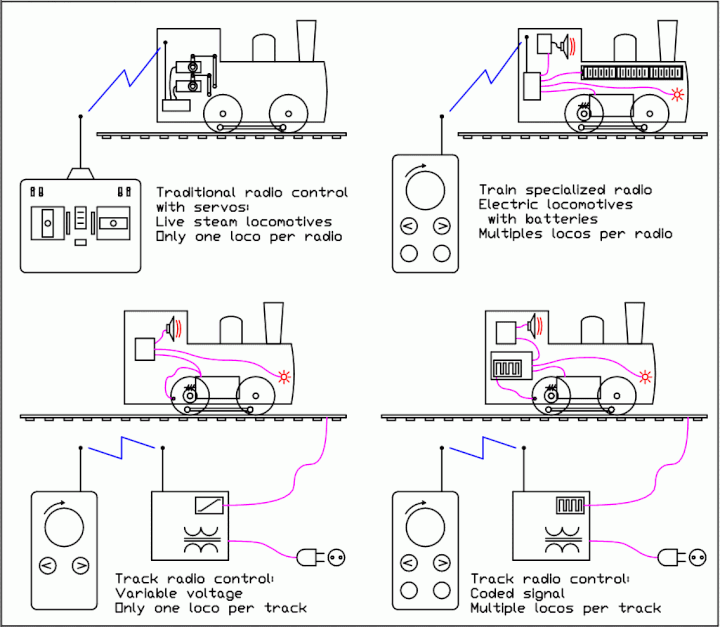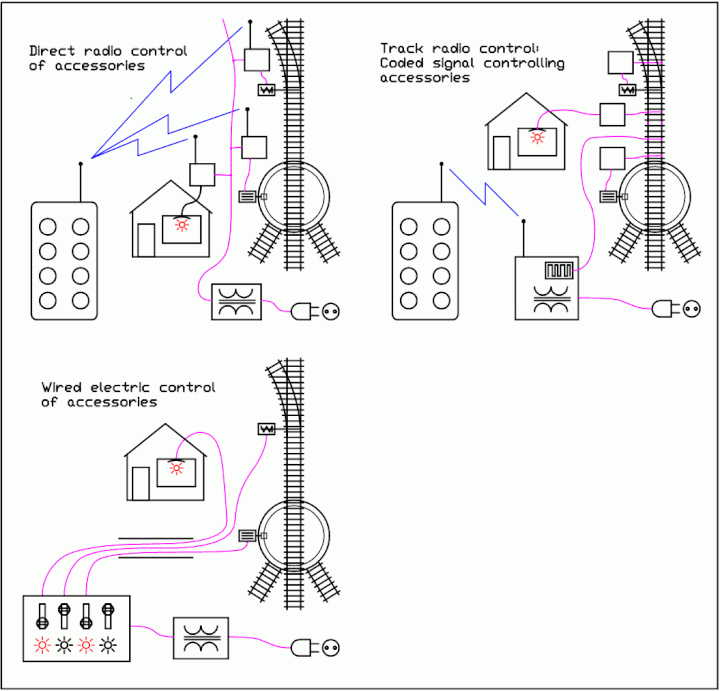This is an old revision of this page, as edited by Rich Farmbrough (talk | contribs) at 01:32, 23 November 2011 (Minor fixes., typos fixed: , → , using AWB). The present address (URL) is a permanent link to this revision, which may differ significantly from the current revision.
Revision as of 01:32, 23 November 2011 by Rich Farmbrough (talk | contribs) (Minor fixes., typos fixed: , → , using AWB)(diff) ← Previous revision | Latest revision (diff) | Newer revision → (diff)| This article needs additional citations for verification. Please help improve this article by adding citations to reliable sources. Unsourced material may be challenged and removed. Find sources: "Garden railway" – news · newspapers · books · scholar · JSTOR (June 2008) (Learn how and when to remove this message) |
| This article may need to be rewritten to comply with Misplaced Pages's quality standards. You can help. The talk page may contain suggestions. (May 2009) |

A garden railroad or garden railway (Railroad in the US, railway elsewhere) is a model railway system set up outdoors in a garden. While G is the most popular scale for garden railroads, 16 mm scale has a dedicated and growing following especially in the UK. Model locomotives in this scale are often live steam scale models of British narrow gauge prototypes. 16 mm scale (which runs on 32 mm / 1.26 in) track, the same gauge as O gauge is probably now more popular in the UK than G scale.
A garden railway's scale tends to be in the range of 1/32 (Gauge 1) to 1/12 (1:12), running on either 45 mm (1.772 in) or 32 mm (1.26 in) gauge track. 1/32 scale (1:32) is also called "three-eighths scale" meaning 3/8 of an inch on the model represents one foot on the real thing. For similar reasons, 1/24 scale (1:24) is also called "half inch scale". Other popular scales are 1:29, 1:20.3 (representing 3' gauge prototypes on 45mm gauge), 16mm (1:19). They are smaller than the Backyard railroad and would not provide a ride on facility, being intended instead as a display railway. Smaller scales and gauges are used in the garden, but in general garden railway is used to refer to the medium scale sizes which would be impractical to use indoors.
Function
At its most basic level, it works just like an indoor railway, including turnouts and turntables. However, special considerations must be taken for everything from sunlight and water to dirt and leaves, and even wildlife. The distance covered also means that electrical resistance in and between sections is much higher, and electrical power will tend to drop off at the far end.
To eliminate this, some are rigged to use RC car parts such as rechargeable batteries. Others even use live steam and run as a real steam locomotive would. The steam can be generated from a variety of sources, ranging from messy solid pellet (i.e. methenamine) or sterno-type fuel, through clean-burning butane gas, to prototypical coal burners. Live steam is particularly widespread amongst 16mm scale garden railway enthusiasts.
Many also have digital audio on-board, so they sound like a real train. They can also use Digital Command Control or other similar systems, though dirty outdoor track can cause less of a problem with signal than with simple DC power. This is because DCC puts the full voltage on the rails at all times. There are many benefits of DCC when compared to DC analog systems.
Design

Plants are usually an integral part of a garden railway, and dwarf varieties along with pruning are often used to keep them in proper proportion. Some go so far as to use bonsai techniques, however this can be very time-consuming for large areas.
Buildings are also often used in a garden railway, though they too must be constructed to withstand the weather. Train stations and freight depots are popular, some even building whole towns trackside. The loco shed is a common place to store a locomotive (or the whole train) when not in use.
Other geographic features are used, such as a small pond to represent a lake, rocks for boulders, or tunnels through "mountains" or under stairways. Tunnels can be a particular challenge, because everything from cats to raccoons and more like to hide in them, particularly to get out of the rain or heat, sometimes even to sleep, nest, or hibernate. A derailment inside a tunnel can also be permanent if careful planning is not done to ensure that it can be reached by access panels (trapdoors) or at arm's length from either end.
A frequent theme is the railway in an idealised urban or rural environment, so it is often found in the context of a model village. Some Garden Railways work opposite to the model village style and opt more for a railway in the garden, where the railways runs amongst normal plants, not in scale with the railway. These sort of railway designs allow for large scale planting and many gardeners have the railway as a secondary hobby to gardening.
Display
Because these layouts are often so unique, they are frequently given names by their owners, just like a real railroad. Some are very natural-sounding, as if they were real. Other names are playful or even silly.
Numerous garden rail societies have been formed around the world. Members often invite others over for social gatherings, as well as rotating club meetings around each month. A large setup is even on public display at the Atlanta Botanical Garden during the summer of 2005 (through early October), including replicas of downtown Atlanta skyscrapers made from wood, bark, and other natural materials.
In Milwaukee, Wisconsin, the Mitchell Park Horticultural Conservatory features an extensive Garden Railway display put on with the cooperation of many Wisconsin Model Railroad club members. The "Domes" as they are know locally, schedules the indoor Garden Railway Show during the cold winter months. It has become one of the most popular displays each year and one of the largest temporary Garden Railway displays in the Midwest.
A notable example in England is Bekonscot which is the oldest model village in the world and has an extensive railway running through a mythical 1930s England. This is well known to be one of the largest, and oldest, garden railways in the UK open to the public.
Technical
Scales
Main articles: Rail transport modelling scales and Rail transport modelling standardsFor historical reasons, the situation is complex.
'G' track width is 45 mm (1.772 in). If used to represent 1,435 mm (4 ft 8+1⁄2 in) standard gauge track, this corresponds to a scale of 1:32.
Same track of 45 mm (1.772 in), if used to represent a 1 narrow (metre gauge) track, corresponds to a scale of 1:22.5 (IIm).
Same track of 45 mm, if used to represent a 36 track, corresponds to a scale of 1:20.3 .
Same track of 45 mm, if used to represent a 24 track, corresponds to a scale of 1:13.5 SE scale, near 1:12 or 1 inch to the foot. This much larger scale is increasing in popularity.
The track of 32 mm (1.26 in), if used to represent a track of 2 ft (610 mm), drive to a scale of 1:19. Though the 1:19 equipment, often live steam locomotive is frequently equipped for a track of 45 mm ('G' track). This scale is also called 16 mm in UK, because it represent 16 mm for 1 ft. This scale is mainly developed in UK.
Same track of 32 mm, if used to represent a 18 track, corresponds to a scale of 1:13.5, this much larger scale is increasing in popularity.
Same track of 32 mm, if used to represent a 15 track, corresponds to a scale of 1:12. This combination is not common but has a small number of dedicated followers.
A US manufacturer decided to creates its own scale of 1:29 for standard gauge trains, on a 'G' track (45 mm / 1.772 in) instead of the 49 mm (1.93 in) track driven by such scale. As its material, mainly built in China is relatively inexpensive, this scale is relatively successful but is limited to representation of US trains.
If one will represent a modern epoch, there is need for road cars and trucks which are only offered in 1:18, 1:24 and 1:32 scale. Modellers are making compromises and 1:22.5 trains are commonly associated with 1:24 accessories (figures, animals, cars, etc.)
There is a conflict on the designation of 'G' scale (created by LGB), the NMRA was initially willing to use it only for scale 1:22.5 but manufacturers hoping to benefit from the notoriety of the 'G' naming continue using this reference for scales 1:20.3, 1:24, 1:29 et 1:32
In short: (width while on scale -> width effectively used)
| Scale | 1:19 | 1:20.3 | 1:22.5 | 1:24 | 1:29 | 1:32 |
|---|---|---|---|---|---|---|
| NMRA reference | F | 1:22 | 1:24 | 1:29 | #1 | |
| MOROP reference | II | I | ||||
| Track, 2 ft (610 mm) | 32 mm | 30->32 mm | - | - | - | - |
| Track, 3 ft (914 mm) | 48->45 mm | 45 mm | - | - | - | 29->32 mm |
| Track, 1 (metre gauge) |
- | 49->45 mm | 45 mm | 42->45 mm | 34->32 mm | 32 mm |
| Track, 1,435 mm (4 ft 8+1⁄2 in) (standard gauge) |
- | - | 64 mm | - | 49->45 mm | 45 mm |
| Road cars & trucks | ->1:18 | - | ->1:24 | 1:24 | ->1:32 | 1:32 |
Scale 1:22.5 is mainly used for narrow gauge equipment and propose a large choice of trains, buildings and accessories (American or European) and allow low radiuses curves, locomotives and cars being shorts.
Scale G64 (64 mm / 2+1⁄2 in), which is the proper width for standard gauge trains at scale 1:22.5 began to develop in UK, but only with UK trains. Large radiuses are required due to the length of cars.
American or European quality equipment can be found at scale 1:32, at a cost.
It exists a few garden trains at a smaller scale but maintenance is more difficult. And the scale '0' with standard gauge run on a track of 32 mm (1.26 in) and is actually at scale of 1:43.5 in France & UK, 1:45 in Germany and 1:48 in the USA...
Common radio control methods
Common switches and accessories control methods
Reference Material
- Aristocraft
- Standard NMRA S1.3
- Standard NEM 010
These will be used to provide citation links:
- Steam trains in your garden, Brian Wilson, Australian Model Engineering Pty Ltd. (No ISBN)
- Practical Garden Railways, Peter Jones, The Crowood Press (ISBN 1861268335)
- The Garden Railway Manual, C.J.Freezer, Patrick Stephens Ltd (ISBN 1852604654)
See also
![]() Media related to Images of garden railways at Wikimedia Commons
Media related to Images of garden railways at Wikimedia Commons
- Backyard railroad — outdoor railways that are large enough to ride on and often cover many acres.
- Ridable miniature railways
- Train ride
- Children's railway
- Gauge 1
- G scale
- 16 mm scale model trains
- SE scale
- Bekonscot Model Village
External links
- Large Scale Online LSOL.com
- Family Garden Trains' Free Articles for Beginners
- MyLargeScale.com
- Large Scale Central
- Garden Railways Magazine
- GIRR Many tips about garden railways construction
- Greg Elmassian Likewise many tips as above
- The Gauge One Model Railway Association
- Garden Trains
Garden railroads
- The Train Garden - English version of Gartenzug
- Andy's Garden Railway
- Guildford Model Engineering Society 16mm Track
Categories:


